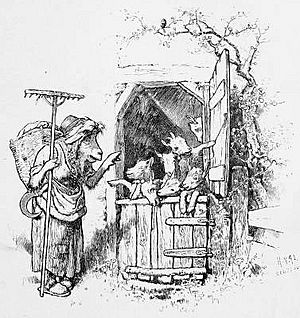The Wolf and the Seven Young Goats facts for kids
Quick facts for kids The Wolf and the Seven Young Goats |
|
|---|---|

Illustration by Hermann Vogel.
|
|
| Folk tale | |
| Name | The Wolf and the Seven Young Goats |
| Data | |
| Aarne–Thompson grouping | ATU 123 |
| Country | Germany |
| Published in | Grimm's Fairy Tales |
The Wolf and the Seven Young Goats (in German, Der Wolf und die sieben jungen Geißlein) is a famous fairy tale. The well-known Brothers Grimm collected and published this story. You can find it in their book, Grimm's Fairy Tales, as story number 5.
This tale is similar to other popular stories like "The Three Little Pigs". It shares themes of clever animals and tricky villains. The part where the baby goats are saved from the wolf's belly is also like how Little Red Cap gets rescued from her wolf.
Contents
Story Origins
This exciting story was first published by the Brothers Grimm in 1812. It was part of their very first collection of Kinder- und Hausmärchen. The Grimm brothers heard this tale from the Hassenpflug family in Hanau, Germany.
Stories like "The Wolf and the Kids" have been told for a very long time. Similar versions were popular in the Middle East and parts of Europe. Some people think these tales might have started as far back as the first century.
The Story of the Wolf and the Goats
Once upon a time, a mother goat lived with her seven young children. One day, she needed to go into the forest to find food. Before she left, she gave her kids a very important warning.
She told them to watch out for the Big Bad Wolf. "He will try to trick you," she said. "He will pretend to be me to get inside." The mother goat explained how to tell her apart from the wolf. "I have a sweet voice and white feet," she told them.
The Wolf's First Trick
After their mother left, the seven young goats stayed safely inside. Soon, they heard a knock at the door. A gruff voice called out, "Let me in, children! Your mother has something for each of you."
The kids immediately knew it was not their mother. Her voice was much sweeter. They shouted back, "No! Your voice is too rough. You are the wolf, and we will not open the door!" The wolf grumbled and walked away.
The Wolf's Second Trick
The wolf was determined. He went to a marketplace and stole some honey. He ate the honey to make his voice sound softer and sweeter. Then, he returned to the goats' house.
Again, he knocked and called out, "Let me in, children! Your mother has something for each of you." This time, his voice sounded high and sweet, just like their mother's. The kids were almost fooled!
But the youngest goat was very clever. He looked through a small crack under the door. He saw the wolf's big, black feet. "No!" he cried. "Your feet are black! You are the wolf, and we will not open the door!" The wolf was angry and left again.
The Wolf's Final Trick
The wolf still did not give up. He went to a bakery and stole some flour. He smeared the white flour all over his black feet and coat. Now, his feet looked white, just like the mother goat's.
He returned to the house one last time. "Let me in, children!" he called, in his sweet, honey-softened voice. "Your mother has something for each of you." The kids saw his white feet and heard his sweet voice. They believed him and opened the door.
The wolf jumped inside! He quickly gobbled up six of the young goats. Luckily, the youngest goat was quick. He managed to hide inside a grandfather clock and was safe.
The Mother Goat's Return
Later that day, the mother goat came home from the forest. She was heartbroken to find the door wide open. Her house was a mess, and all but one of her children were gone. She called out for her kids.
The youngest goat peeked out from the clock. He told his mother what had happened. The mother goat then saw the wolf. He was fast asleep under a tree, his belly huge from eating so much.
The mother goat quickly told her youngest child to get her some scissors, a needle, and thread. She carefully cut open the wolf's belly. To her joy, all six of her children popped out, safe and sound!
The Wolf's Punishment
The mother goat and her children had a clever idea. They quickly gathered many heavy rocks. They filled the wolf's belly with the rocks. Then, the mother goat carefully sewed his belly back up.
When the wolf finally woke up, he felt very thirsty. He walked to the nearby river to get a drink. But the rocks in his belly were too heavy. He lost his balance, fell into the river, and drowned.
The mother goat and her seven children were finally safe. They lived happily ever after, always remembering to be careful and clever.
See also
 In Spanish: El lobo y las siete cabritillas para niños
In Spanish: El lobo y las siete cabritillas para niños

